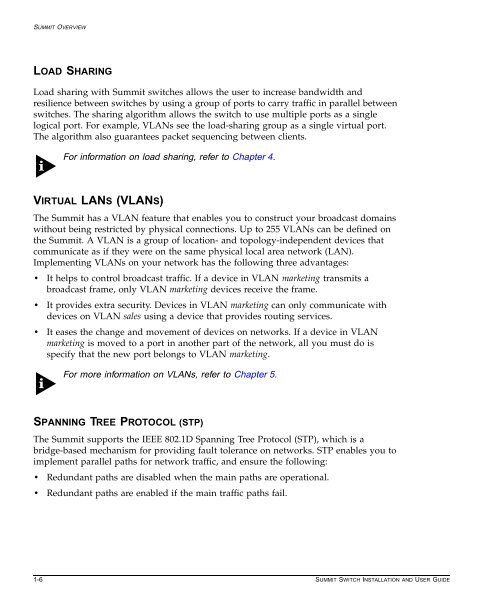Summit Installation and User Guide - Extreme Networks
Summit Installation and User Guide - Extreme Networks
Summit Installation and User Guide - Extreme Networks
You also want an ePaper? Increase the reach of your titles
YUMPU automatically turns print PDFs into web optimized ePapers that Google loves.
SUMMIT OVERVIEW<br />
LOAD SHARING<br />
Load sharing with <strong>Summit</strong> switches allows the user to increase b<strong>and</strong>width <strong>and</strong><br />
resilience between switches by using a group of ports to carry traffic in parallel between<br />
switches. The sharing algorithm allows the switch to use multiple ports as a single<br />
logical port. For example, VLANs see the load-sharing group as a single virtual port.<br />
The algorithm also guarantees packet sequencing between clients.<br />
For information on load sharing, refer to Chapter 4.<br />
VIRTUAL LANS (VLANS)<br />
The <strong>Summit</strong> has a VLAN feature that enables you to construct your broadcast domains<br />
without being restricted by physical connections. Up to 255 VLANs can be defined on<br />
the <strong>Summit</strong>. A VLAN is a group of location- <strong>and</strong> topology-independent devices that<br />
communicate as if they were on the same physical local area network (LAN).<br />
Implementing VLANs on your network has the following three advantages:<br />
• It helps to control broadcast traffic. If a device in VLAN marketing transmits a<br />
broadcast frame, only VLAN marketing devices receive the frame.<br />
• It provides extra security. Devices in VLAN marketing can only communicate with<br />
devices on VLAN sales using a device that provides routing services.<br />
• It eases the change <strong>and</strong> movement of devices on networks. If a device in VLAN<br />
marketing is moved to a port in another part of the network, all you must do is<br />
specify that the new port belongs to VLAN marketing.<br />
For more information on VLANs, refer to Chapter 5.<br />
SPANNING TREE PROTOCOL (STP)<br />
The <strong>Summit</strong> supports the IEEE 802.1D Spanning Tree Protocol (STP), which is a<br />
bridge-based mechanism for providing fault tolerance on networks. STP enables you to<br />
implement parallel paths for network traffic, <strong>and</strong> ensure the following:<br />
• Redundant paths are disabled when the main paths are operational.<br />
• Redundant paths are enabled if the main traffic paths fail.<br />
1-6 SUMMIT SWITCH INSTALLATION AND USER GUIDE

















